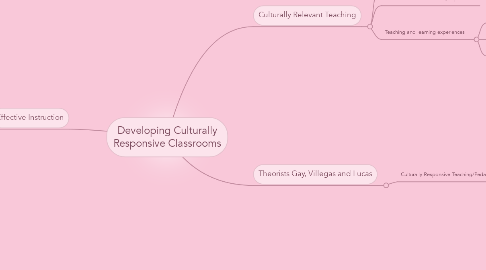
1. Effective Instruction
1.1. Expand on the curriculum
1.2. Use inquiry-based approaches to develop engaged and self-directed learners
1.3. Use variety of resources
1.4. See the curriculum as flexible and adaptive to the lived experiences of students so that they are reflected in their learning expriences
1.5. Build on students' prior knowledge
1.6. Consider students' interests, strengths, and learning styles
1.7. Provide learning opportunities to engage broad range of learners, perspectives, learning styles, and sources of knowledge
1.8. Differentiate instruction
1.9. Develop on socio-cultural consciousness of students
2. Culturally Relevant Teaching
2.1. Students' background knowledge
2.2. Prior home and community experiences
2.3. Teaching and learning experiences
2.3.1. Holding high expectations
2.3.2. Developing cultural competence
2.3.3. Developing critical cultural consciousness
3. Theorists Gay, Villegas and Lucas
3.1. Culturally Responsive Teaching/Pedagogy
3.1.1. All students learn differently
3.1.2. Cultural uniqueness of students
3.1.3. Student Diversity is student strength
3.1.4. Three dimensions of Culturally Responsive Pedagogy
3.1.4.1. Institutional
3.1.4.1.1. Administration
3.1.4.1.2. School board policies/practices
3.1.4.2. Personal
3.1.4.2.1. Culturally responsive educators
3.1.4.3. Instructional
3.1.4.3.1. Knowing learners well
3.1.4.3.2. Classroom practices
3.1.5. Culturally Responsive Educators Mindset
3.1.5.1. Socio-cultural consciousness
3.1.5.2. Desire to make a difference
3.1.5.3. High expectations
3.1.5.4. Constructivist Approach
3.1.5.5. Culturally responsive teaching practices
3.1.5.6. Deep knowledge of students

